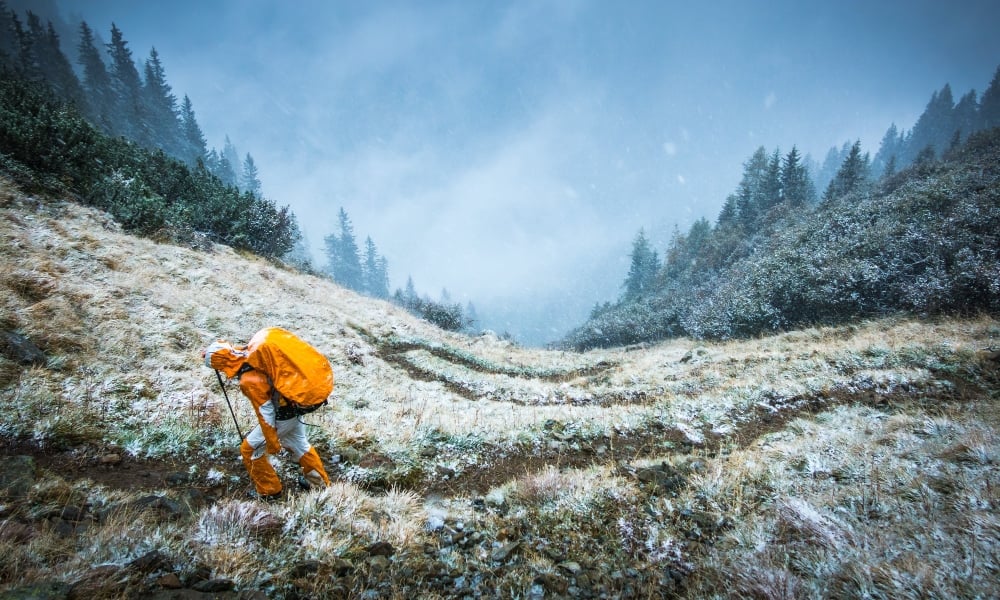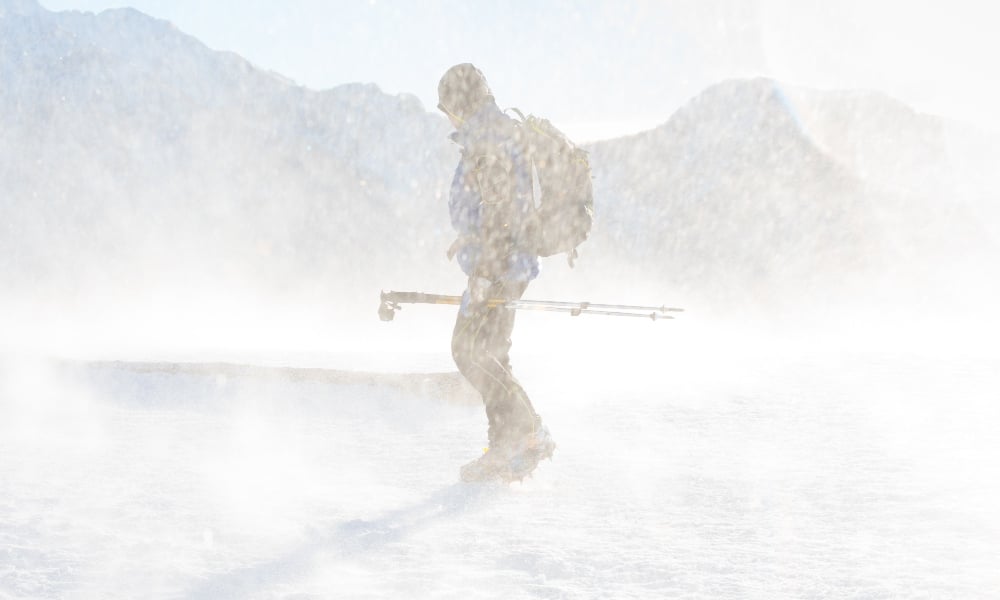Spend enough time in the mountains and you learn to expect the unexpected. You might start out in delightfully warm weather and then, surprise, a storm arrives and covers the landscape in snow. Didn’t see that coming!
In the second article in this series on wayfinding, we talked about how to plan a route in the mountains. In the third article, we explained how to stay on track when you’re out on a trip. In this article we look at how to react when conditions get difficult.
Thing is, even the best laid plans can and probably will go awry. It’s important to understand your plan is just a plan. The world around you marches to its own drumbeat.

Photo by Tim Tiedemann on Unsplash
3 general rules
Be responsive
Our resident navigator-in-chief Terho Lahtinen advises to expect the unexpected. You don’t want to get too vigilant and uptight, however, because then nothing is much fun. Just keep it in the back of your mind that things can change, and to be responsive when they do.
Terho says to cultivate this quality it’s good to go through different scenarios in advance of the trip and to have plans for each of them.
“In the mountains, you should always have a plan B for surprises: a shorter route, extra clothing, first aid kit, backup navigation device, and so on,” he says. “Having the right equipment and skills to use them properly is the best preparation.”
Stay calm
Goes without saying, but when things take a turn for the unexpected it’s important not to panic. Panic impairs our decision making ability, which can be a big deal in the backcountry. Instead, do something to help you relax.
“When you encounter an unwanted situation, make a stop, have a snack, find shelter if possible and put on an extra layer to keep warm,” Terho says. “It’s more important to make the right decision rather than a quick one that turns out wrong.”
Consider all options
Once you’ve settled down, consider all your options. Talk with your group and see how everyone is feeling. What options suit the skill level and comfort zone of your group?
“Sometimes the conditions are just not on your side and the only reasonable plan B is to postpone the trip,” Terho says. “This can be a very hard decision if it’s a long-awaited adventure, but it’s better to be safe than sorry.”
This is when a Suunto 9 comes in handy. The watch’s Find Back function guides you directly back to your starting point via a breadcrumb trail on the watch face. You can also store Points of Interest on the go and navigate back to them.

Photo by asoggetti on Unsplash
Specific rules for low visibility
One typical thing that can catch people out in the mountains is poor visibility, whether caused by fog, rain, snow or low light. You have to pay extra attention in any of these conditions, and really consider what options are the best for you and the group.
Easy does it
In low visibility always choose the easiest route to follow. Stay on a marked trail instead of taking an off track shortcut.
“If there are no trails, use obvious terrain features as checkpoints that you are sure to recognize,” Terho says.
Know your location
One of the ways people get into trouble in the mountains is by pushing on hastily without being sure about their location. In low visibility, take the time to regularly check in with your map.
“If you lose your location on the map, it is much more difficult to find it again if you can’t see your surroundings,” Terho says. “In practice, you will need to pay attention to all details in the terrain that you can identify on the map, and also work through the terrain features that you expect to see when moving on.”
Keep track of time
Monitoring your travel time is essential to estimate the distance you have traveled. This is important because in low visibility it will help you estimate where you likely are on the map.
“It’s worth noting that in poor visibility we tend to overestimate the distance traveled and the pace often gets slower when visibility drops,” Terho says. “When trying to spot yourself on the map, remembering this limits the radius of where to look on the map.”

A stream can act as a handrail to lead you to the next terrain feature. Photo by Hamed Alayoub on Unsplash
Follow handrails
We talked about using handrails as navigation aids in the previous article in this series. They can be particularly useful in low visibility, even as reassurance.
“A good handrail is a clear terrain feature that you can easily follow, such as a creek, river, hillside, a fence or the treeline,” Terho explains. “Sometimes you can also use the elevation of the handrail as an additional navigation aid.”
Use all your tools
When you’re way out in the backcountry far from help or above the treeline and exposed to the elements, time is of the essence. Cold is the enemy. Use all your tools to help you stay on track and safe. Your compass, watch, altimeter, GPS device – each one can help you.
“Use your compass to check the trail you’re on goes in the right direction,” Terho says. “Check the time every now and then; knowing your average pace and the time in the last known location helps to estimate how far you could have traveled. An altimeter is also a practical tool. For instance, working out your location on a trail that goes up or down a slope can be done with an altitude reading. As a backup, it’s also good to have a GPS like a Suunto 9 watch with the most important waypoints and the planned route stored.”
Wait it out
Sometimes the best thing you can do is to find shelter asap. Especially in cold conditions, staying warm is the priority. Hypothermia, when your body loses heat faster than it can produce it, can set in within minutes to hours, depending on the temperature.
“There are times when the best option is to pitch camp, sleep over and evaluate the options again next morning,” Terho says.
Lead image: Photo by Philipp Reiter
Read more articles
How to find your way in the mountains
7 tips to plan a route in the mountains
A veteran navigator's 9 tips to stay on track in the mountains